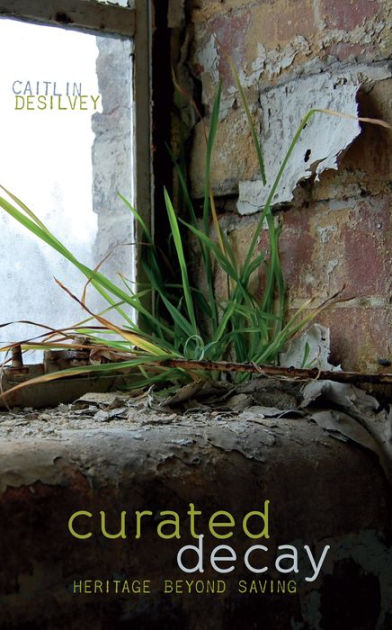
Curated Decay (2017) Caitlin DeSilvey
This is essential reading for anyone interested in the aesthetics of care and ecology. In this book, Caitlin DeSilvey challenges the accepted norms of preservation and conservation of heritage sites in the context of both entropic and ecological challenges. Ultimately DeSilvey provocatively proposes working with, as opposed to against, as being the basis for ethical conservation. The challenge of such an approach is that it reckons with the limitations of conservation and preservation, recognising that sometimes sites are beyond care and rescue. In these contexts, a palliative approach is proposed (161). Premised on
experimental heritage practice that sees its objects of concern as temporary arrangements of matter that shuttle between durability and vulnerability in response to social and physical forces often outside our control. (8)
Practices of overcare, as in the case of Orford Ness (93) are considered and much is made of Greg Kennedy’s Heidegger and Buddhist influenced “distinction between care that imposes its will on an external world of things and beings, and care that establishes a relation with the cared for, and allows that relationship to work back on the self in unpredictable ways” (179- originally from Greg Kennedy, An Ontology of Trash: The Disposable and Its Problematic Nature). Care that imposes and care that relates to ecology can each be conceived on aesthetic terms but the latter is certainly rooted in care.
The value of this text for consideration of the aesthetics of care with ecology is that it directly and explicitly overcomes the common assumptions of conservation and preservation. Refreshingly it approaches heritage objects as heritage inherently temporary, vulnerable to climate changes and material decay. While DeSilvey is concerned with a variety of practices of heritage preservation it is not a short jump to other areas of aesthetics (such as education and artistic practice). For although this book is about heritage beyond preservation it is also about preservation beyond heritage, by which I mean all the other ways that society valorises preservation, archiving and collecting. It also riffs on medical ethics.
Ultimately her approach points to the potentials in the aesthetic appreciation not only of decay but of anything in motion or abandoned. As such this aesthetics of entropy is inspired by the “emergent aesthetics” of Tim Edensor. The potency of the text lies in its rethinking of (heritage) preservation and pointing to ways of care that allow for an almost existential recognition of letting go and embrace of entropy and retirement of aesthetic objects.
If we accept that our buildings have lives, then we also must accept that they, like us, have deaths (p. 159).
Such a shift in paradigmatic preservationist thinking points to a post humanist aesthetics of care in the heritage field. Where the common paradigm seeks to fix and affix a static state on a site, De Silvey seeks to recognise the life of ‘ruins’ beyond the contemporary model of the “cultural resource”. I am dubious as to the success of such narrative fixing of ruins, as De Silvey herself points out:
As soon as these sites become present as objects of concern, their mixed and mutable identity is framed as a problem to be solved. (p. 130)
The mutability of meaning of sites is a central aspect of their operation. This includes the way that plants ‘renaturalise’ sites. Following the metaphor of composing used by Katerina Saltzman she proposes:
a compostheritage practice that insists we are never “post” anything but that instead we carry our inherited (and invariably moldy) ideas with us as we move forward into new modes of action and attention. (151)
The question of when to apply the “positive passivity” (115) of an aesthetics of care that recognises entropy is not considered. This is something that the author recognises (165). Likewise, she recognises in the conclusion that the idea of heritage beyond preservation is something that could be weaponised by forces that seek to defund the arts and culture. It is certainly conceivable that the jargon of “curated decay”, “palliative curation” even “compostheritage” etc. will soon be employed in that way, especially when it comes to contentious heritage. This is particularly the case as it is rarely clear when heritage intervention must step back. Thought provoking.
Connell Vaughan
TU Dublin
DeSilvey, Caitlin. Curated Decay: Heritage beyond Saving. Minneapolis; London: University of Minnesota Press, 2017.
ISBN: 9780816694389
